|
|
|
Sort Order |
|
|
|
Items / Page
|
|
|
|
|
|
|
| Srl | Item |
| 1 |
ID:
118425
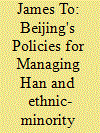

|
|
|
|
|
| Publication |
2012.
|
| Summary/Abstract |
The overseas Chinese (OC) form a vast network of powerful interest groups and important political actors capable of shaping the future of China from abroad by transmitting values back to their ancestral homeland (Tu 1991). While the Chinese Communist Party (CCP) welcomes and actively seeks to foster relations with the OC in order to advance China's national interests, some cohorts may be hostile to the regime. In accordance with their distinct demographic and ethnic pro-files, the CCP's qiaowu (??, OC affairs) infrastructure serves to entice, co-opt, or isolate various OC groupings. This article summarises the policies for managing different subsets of OC over the past three dec-ades, and argues that through qiaowu, the CCP has successfully unified cooperative groups for China's benefit, while preventing discordant ones from eroding its grip on power.
|
|
|
|
|
|
|
|
|
|
|
|
|
|
|
|
| 2 |
ID:
118422
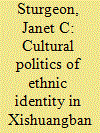

|
|
|
| 3 |
ID:
118419
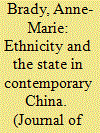

|
|
|
| 4 |
ID:
118420
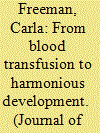

|
|
|
|
|
| Publication |
2012.
|
| Summary/Abstract |
For six decades, China's central authorities have promoted development in ethnic regions through special fiscal allocations with the idea that economic development is the key to national integration and inter-ethnic harmony. Yet, inter-ethnic tensions and violence persist in China. Focusing on historical changes to fiscal allocations as the principal policy instrument used by Beijing to promote development in ethnic areas, this analysis finds these changes mirror broad shifts in the country's national development strategy. As the study argues, this pattern reflects an approach to development policy in ethnic regions whereby policies serve central objectives consistent with a policy process for determining the fiscal allocations to ethnic regions that has been both centrally concentrated and non-participatory. With evidence that this "non-engaging" approach may be exacerbating ethnic tensions, Beijing has made efforts to introduce more "inclusive" approaches to determining policies for ethnic regions; however, whether these approaches will be institutionalized remains unclear.
|
|
|
|
|
|
|
|
|
|
|
|
|
|
|
|
| 5 |
ID:
118421
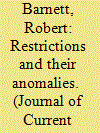

|
|
|
|
|
| Publication |
2012.
|
| Summary/Abstract |
In 1994, at a meeting known as the Third Forum on Tibet Work, the Chinese authorities announced a series of restrictions on religious practice in the Tibetan Autonomous Region. Described by many outsiders in terms of abuses of rights, in fact those measures differed in important ways. By analysing the target, rationale and procedure of these restrictions, it becomes clear that some were relatively routine, while others were anomalous - their purpose was not explained by officials, the source of their authority was not clear, or the restrictions were simply not admitted to at all. These anomalous orders can be linked to major changes in underlying discourses of modernization and development among officials in Tibet at the time. They reflected undeclared shifts in attitudes to religion and cultural difference, and seeded the dramatic worsening in state-society relations that has taken place in Tibetan areas since that time.
|
|
|
|
|
|
|
|
|
|
|
|
|
|
|
|
| 6 |
ID:
118423


|
|
|
|
|
| Publication |
2012.
|
| Summary/Abstract |
This paper outlines the operation of what may be called "political tourism" in China, and analyses the role of the sensorial technology of "seeing" in the kind of narrative this tourism engenders. Beginning in 1950, the newly established People's Republic of China launched an annual tradition of inviting non-communist elites to attend the May Day and the National Day (1 October) parades on Tiananmen Square in Beijing and in some metropolitan cities. Unlike contemporary ethnic tourism, wherein minorities and their cultures become the objects of the tourist gaze, Chinese political tourism aims at bringing minority leaders out of their putative "isolation", treating them with hospitality, and ultimately making them "see with their own eyes" China's "true face".
|
|
|
|
|
|
|
|
|
|
|
|
|
|
|
|
| 7 |
ID:
118424


|
|
|
|
|
| Publication |
2012.
|
| Summary/Abstract |
The Chinese Communist Party (CCP) government works hard to promote an image of ethnic harmony in China and downplays ethnic conflict by carefully controlling public information and debate about ethnic affairs. Despite such efforts, the recent clashes in Tibetan areas in 2008 and violent riots in Urumqi in 2009 reveal the weaknesses of this approach. This paper surveys the broad themes of ethnic propaganda (????, minzu xuanchuan) in present-day China, looking at the organisations involved, the systems of information management they utilise, and the current "go" and "no-go" zones for debate. The paper forms part of a larger study of the politics of ethnicity in China. It is based on primary- and secondary-source research in Chinese, secondary sources in English, and extensive interviews with Chinese bureaucrats and scholars regarding China's ethnic affairs conducted during fieldwork in China in 2002, 2004, 2005-2006, 2007, 2009, 2010 and 2012. Ethnic issues in China concern not only the minority peoples there, but also the majority Han - hence, my definition of ethnic propaganda incorporates materials relating to all of China's ethnic groups. The paper uses the events in Tibetan areas in 2008 and in Urumqi as case studies to demonstrate how these policies play out in periods of crisis. It concludes with a discussion of the role that ethnic propaganda plays in maintaining China's long-term political stability and its international affairs.
|
|
|
|
|
|
|
|
|
|
|
|
|
|
|
|
|
|
|
|
|